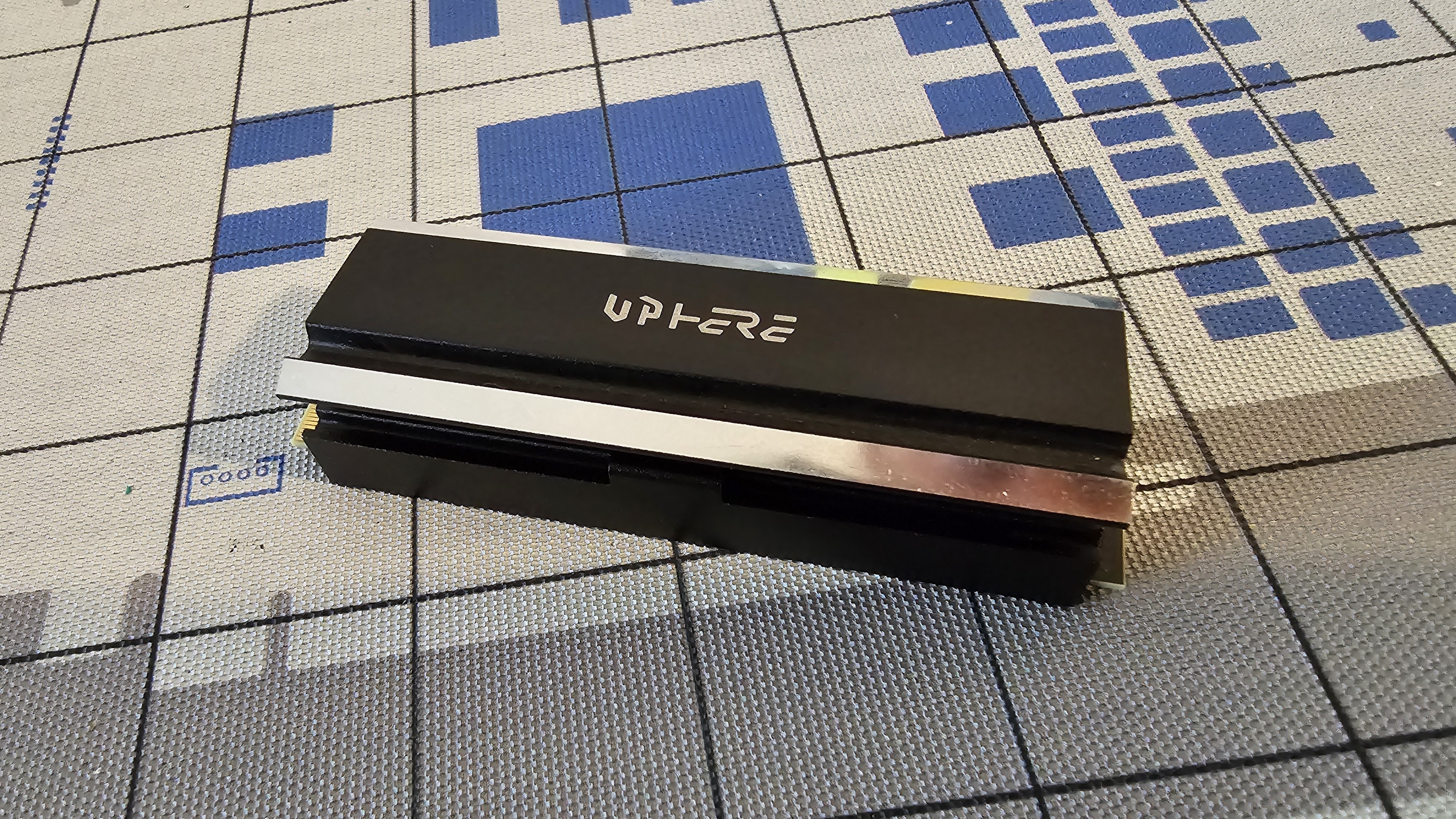Why you can trust Tom's Hardware
Thermal Performance
If you look at the temperatures on the chart alone, the results will be a little misleading. When I’ve tested SSD heatsinks on this platform, I’ve always used a 360mm AIO for consistency. When paired with an AIO, the SSD does reach its peak temperature during stress testing.
You’ll notice that while the graph below shows that the SSD reached its peak temperature of 82C while paired with an AIO, it is listed *above* the throttling point for PCIe 4 systems. This is because while the SSD did run hot, it did not throttle – sustaining the maximum performance possible on this testing platform.
But this doesn’t quite tell the whole story, because these smaller types of NVMe heatsinks are designed to be used in conjunction with an air cooler. I tested this heatsink with Thermalright’s Phantom Spirit 120 EVO, and with this pairing, UpHere’s M201 heatsink was able to keep the SSD under its peak temperature in my stress tests.
Due to this finding, I’ll be changing how I test heatsinks. While I will continue to test most SSD heatsinks with an AIO installed, most smaller units like UpHere’s M201 will be tested with an air cooler in future reviews.
Conclusion
UpHere’s M201 NVMe SSD Heatsink provides essential cooling performance sufficient for most users, and its small profile means that it doesn’t suffer from compatibility issues. Its installation could be a little easier, but that’s something we’re willing to overlook on a product that only costs $4.99 USD.
Get Tom's Hardware's best news and in-depth reviews, straight to your inbox.

Albert Thomas is a contributor for Tom’s Hardware, primarily covering CPU cooling reviews.
-
thestryker This seems like the best design I've seen for the cheap ones, but that retention mechanism makes me wonder how it would hold up over a long period of time.Reply
I've been kicking around replacing the Thermalright AB I have on my OS Optane drive as it actually runs so it's 10-12C hotter than the other ones. The problem I have is that I don't have much room height wise so I think this would be just enough taller it wouldn't fly as my NIC has a heatsink in the way. Been contemplating trying the Thermalright M.2 2280 PRO and since it's pretty cheap I may just do that, but off the reviews here I think the BeQuiet MC1 PRO is probably the only other one small enough to really consider. -
SyCoREAPER I'm using the HR09 Pro (absolute unit) from the chart for cooling and have had good results. Not because I think it's necessarily a good design but rather air can actually reach it since the RAM was blocking it before.Reply
One thing is for sure, definitely not a fan (no pun intended) of ones with fans. Those tiny things are usually loud, odd/annoying auditory frequency. -
Albert.Thomas Reply
Honestly, I'd probably recommend Iceberg Thermal's IceFLOE instead. It's slightly more expensive, but barely, and has a much better installation process.thestryker said:This seems like the best design I've seen for the cheap ones, but that retention mechanism makes me wonder how it would hold up over a long period of time.
I've been kicking around replacing the Thermalright AB I have on my OS Optane drive as it actually runs so it's 10-12C hotter than the other ones. The problem I have is that I don't have much room height wise so I think this would be just enough taller it wouldn't fly as my NIC has a heatsink in the way. Been contemplating trying the Thermalright M.2 2280 PRO and since it's pretty cheap I may just do that, but off the reviews here I think the BeQuiet MC1 PRO is probably the only other one small enough to really consider. -
Albert.Thomas Reply
Yeah, you definitely don't want or need them to run at full speed. I usually run them at 67% PWM.SyCoREAPER said:I'm using the HR09 Pro (absolute unit) from the chart for cooling and have had good results. Not because I think it's necessarily a good design but rather air can actually reach it since the RAM was blocking it before.
One thing is for sure, definitely not a fan (no pun intended) of ones with fans. Those tiny things are usually loud, odd/annoying auditory frequency. -
thestryker Reply
Ironically the terrible retention method would work better for the drives I have in addon cards as there isn't enough room to put screws in on the near sides for each drive. Those drives are all just caching drives so I've never had any temp problems there though so I'm not particularly worried about it (they have Type AB with screws on one side).Albert.Thomas said:Honestly, I'd probably recommend Iceberg Thermal's IceFLOE instead. It's slightly more expensive, but barely, and has a much better installation process.
For the P1600X I'm using as a boot drive I went ahead and got the Thermalright M.2 2280 PRO and so far it's running about 10C cooler than the Type AB it replaced. I just changed it today so it'll probably take a while to be sure how much better it is as the system is in operation. Realistically it wasn't really an issue before as it was running ~51C, but I knew the cooler was the majority of the reason there.
edit: drive seems to have stabilized at 42C and previously it was 51C, but if something changes I'll update this post. Would really like to see where the M.2 2280 PRO falls on your testing list here.



